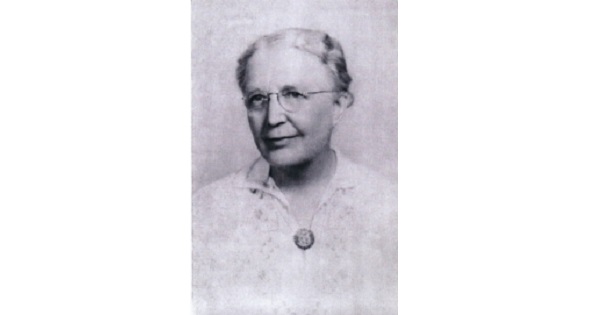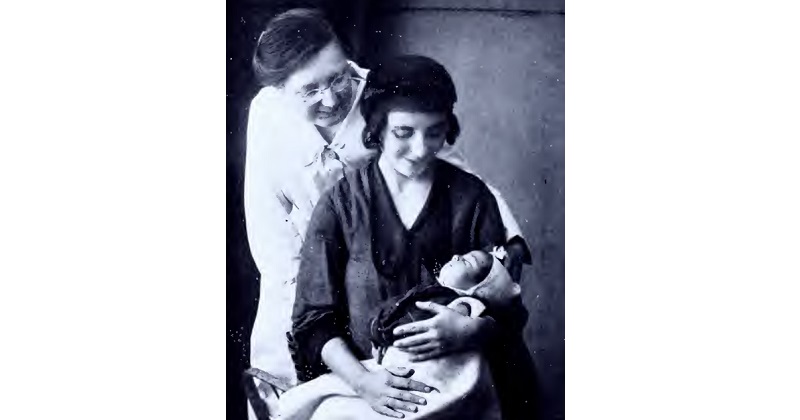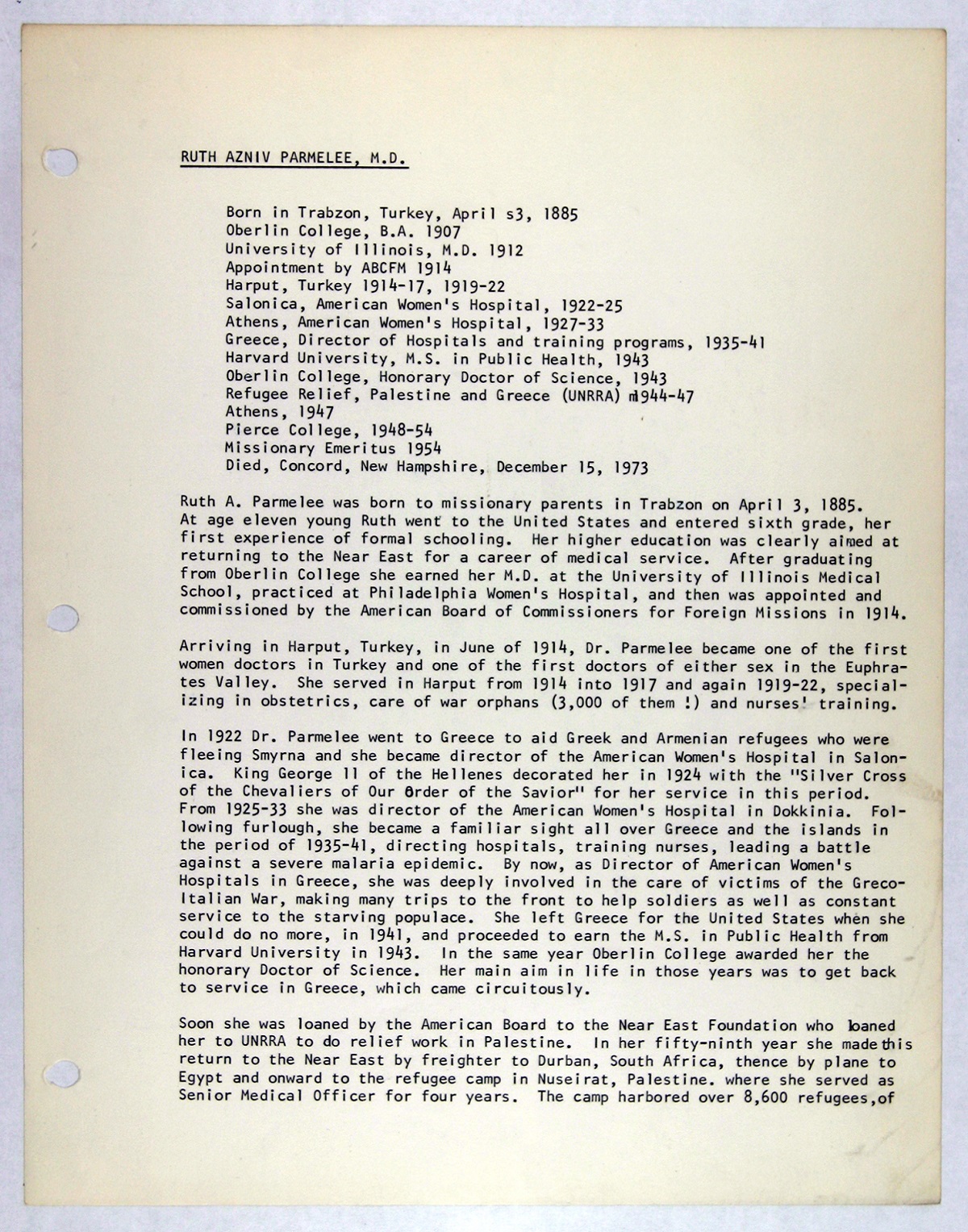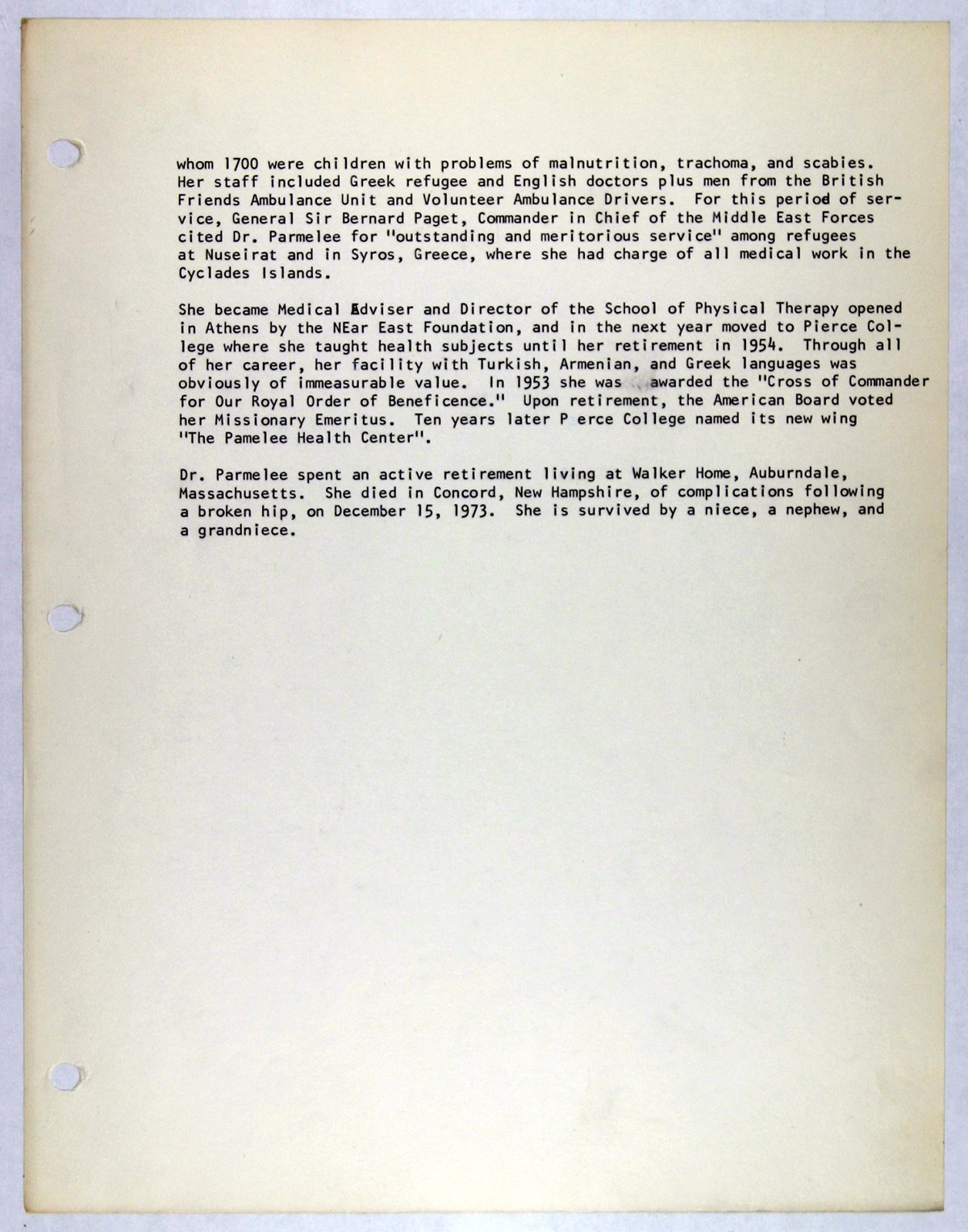
Portrait of Ruth Parmelee from the frontispiece of her privately printed booklet A Pioneer in the Euphrates Valley, 1967. Courtesy: Armenian News Network, Groong.
Dr. Ruth Azneve Parmelee (1885-1973) was a medical missionary who witnessed the persecution of Christians during the genocide in Ottoman Turkey and cared for the survivors. She was born in Trebizond (today Trabzon, Turkey) to parents who were both missionaries. Her father, Dr. Moses Payson Parmelee M.D was a Christian missionary for the American Board of Commissioners for Foreign Missions (ABCFM) and was based in Trebizond since 1863. After initially studying with her parents, at the age of 11 she travelled to the United States to obtain formal study. She received her B.A from Oberlin College in 1907 and her M.D from the University of Illinois in 1912.1
In 1914, Parmelee was appointed and commissioned by the ABCFM and returned to Turkey where she set up a medical practice in Harput specializing in obstetrics, training nurses and taking care of orphans. She is considered one of the first women doctors in Turkey and one of the first doctors of either sex in the Euphrates Valley. She continued this work until 1917 then resumed the post from 1919-1922.
Parmelee, who was fluent in many of the Near East languages including Greek, Armenian and Turkish was also the head of the Harput Hospital of the Near East Relief. During her time there, she opened a baby hospital to take care of refugee mothers and their babies. At one stage, she was in charge of 5,000 orphans who were being supported by the Near East Relief.2 In 1922, Parmelee, along with two other relief workers, Dr. Mark H. Ward and Isabelle Harley were expelled from Turkey. Parmelee had been particularly sympathetic toward the persecuted Christians, as was Mark Ward who kept notes on the deportations which were being planned and executed by the Kemalists at the time. Parmelee wrote: "What is the civilized world going to do about… [the Turkish government’s] steady oppression of the Armenians and the deportation of so many of the Greeks?"3
In October 1922, she went to Thessaloniki, Greece to help the Christians who had survived persecution and had been expelled from Turkey, the country where she was born. She directed medical work in the Thessaloniki district for the American Womens Hospitals (AWH). Some of her assistants were refugee physicians and nurses who had served with her in Harput. Her work in the Thessaloniki district included training nurses and organizing camp services, clinics and a 100 bed hospital. The Thessaloniki Hospital played a crucial role in providing medical aid to sick and undernourished genocide survivors. It also became a refuge for expectant mothers. During the first few months, over 500 children were born there.4 From 1925-1933, she was the director of the AWH hospital in Kokkinia (today Nikaia), a suburb in Athens situated close to the port of Pireaus. At the same time, she continued to run the school of nursing which had moved with her from Thessaloniki.

Dr. Ruth Parmelee (standing) with a refugee mother and child. Source: Esther Pohl Lovejoy, Certain Samaritans. New York, 1927.
In 1941, Parmelee left Greece due to the German occupation. She later returned to Athens and from 1946-1947 acted as Medical Advisor and Director of the Near East Foundation's School of Physical Therapy. After a leave of absense in the US, she returned to Greece again and from 1948-1953 served at the Pierce College in Elleniko near Athens teaching hygiene, community health and medical information to social wokers. She returned to the US and died in 1973.
Ruth Parmelee served in Greece over three decades and was bestowed a number of awards. In 1924, King George II of Greece awarded her the Silver Cross of the Chavaliers of our Order of the Savior while in 1953 King Paul appointed her the Order of Beneficience (Tagma tis Efpiias).
Memorial record for Ruth A. Parmelee, an employee of the American Board.5
1. Online Archive of California, Register of the Ruth A. Parmelee papers, Biographical note. https://oac.cdlib.org/findaid/ark:/13030/kt596nf1c5/admin/ accessed 12 Aug 2021.
2. Near East Relief, Vol. IV, No. 19. May 13, 1922, p.1.
3. Ruth Parmelee, typescript, “Relief Work at Harpoot, Turkey, 1919-1922,” 5, in Ruth Parmelee Papers, Box #2, Folder, Correspondence, Selected Reports, Hoover Institution, Stanford University, Palo Alto, California. Quoted from Virginia Metaxas, Working with the Sources: The American Women's Hospitals in the Near East, Drexel University Legacy Center, accessed 12 Aug 2021, https://drexel.edu/legacy-center/blog/overview/2014/october/working-with-the-sources-the-american-womens-hospitals-in-the-near-east-full-article/
4. Esther Pohl Lovejoy, Certain Samaritans. New York, 1927. p.275.
5. Amerikan Bord Heyeti (American Board), Istanbul, "Memorial records for Ruth A. Parmelee," American Research Institute in Turkey, Istanbul Center Library, online in Digital Library for International Research Archive, Item #17332, http://www.dlir.org/archive/items/show/17332 (accessed August 14, 2021).
Further Reading:
Ruth Parmelee's description of the 1915 Harput deportations including rare photos, Armenian News Network/Groong.
6 May 1922: Killing by Turks has Been Renewed, The New York Times.
Dr. Mark Hopkins Ward (Near East Relief)





